Is there anything more fun than sitting back and taking shots at a film that plays around in a narrative sandbox that you know front to back?
Well, probably: Roller coasters are a hell of a good time, but right behind all those banked turns and double loops has to be the haughty satisfaction of confidently calling bullshit on a movie trope or scene that painfully misses key realities or details.
And now that every person in the world has experienced a pandemic first-hand, the movies that deal in this currency are set for a brutal re-evaluation, with only the best of the bunch likely to survive a new critical reckoning.
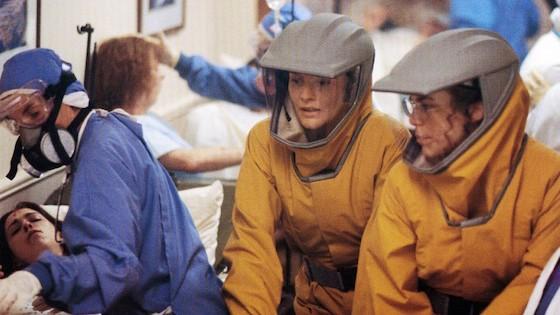
Today’s Top 10 is a celebration of the films that got pandemics more or less correct from the micro or macro (or both) side of things. Movies that best captured the intimate paranoia and/or the broad social cataclysm of a plague earned a slot in the ranking below, and moved closer to the #1 position as they touched on crucial truths that are known only to those who have lived through them. The caginess of quarantine, deserted cities, paranoia of crowds, runs on resources, fumbled government responses, and exploitation of fear all define at least some phase of a global pandemic, and the proper use and/or combination of them earned the films listed today a spot in the ranking.
Now for the sticky bits.
Today’s Top 10 is exclusively limited to biological (not environmental) plagues that triggered a global pandemic resulting in death without any post-mortem reanimation. Indeed, if zombies were allowed into today’s conversation, this would be a different conversation. So, although it was a virus, 28 Days/Weeks Later was sadly excluded, along with World War Z, Maggie, and other films of that ilk. Alien invasions or other supernatural chaos agents (a la Invasion of the Body Snatchers, A Quiet Place, Birdbox, etc.) also fell out of the conversation, for like the zombie genre, that is a whole other ball of wax. We only settled for the best of the bunch in what remained, so without further ado, let’s kick things off with…
10. Hidden (2015)

There weren’t many people who saw this film when it first came out in 2015, but scores have rediscovered it since, owing in large part to the directors who made Hidden. Yep, a year before Stranger Things premiered, Matt and Ross Duffer wrote and directed this post-apocalyptic yarn about a mother (Andrea Riseborough), father (Alexander Skarsgård), and daughter (Emily Alyn Lind) trying to stay one step ahead of a deadly virus ravaging the U.S. Although the trio find some safety in an abandoned fallout shelter a little less than a year after the initial outbreak, “breathers” wander above and threaten to discover their small oasis. Struggling with cabin fever in the confined space and threatened by a rat that somehow made its way into the shelter, the parents fall victim to a series of unfortunate accidents that threaten to reveal their hiding space. Flashbacks provide a few glimpses of life at the start of the pandemic, which are just a little too familiar to 2020 eyes and should be enough to get anyone watching a little antsy in their seat. And while the film never features any postmortem reanimation, there are enough elements that make this one feel somewhat zombie-adjacent, which is the only reason it came in at the #10 spot, right behind…
9. Doomsday (2008)
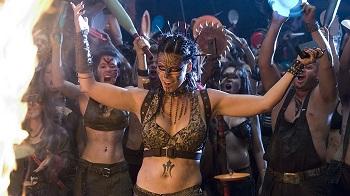
A post-apocalyptic blood-and-guts corker from director Neil Marshall, Doomsday tells the story of a quarantined England that has walled Scotland off following the outbreak of the “Reaper Virus.” 27 years after the quarantine of the Scots, England’s Prime Minister (Alexander Siddig) sends a team of soldiers and scientists to track down rumors of a possible cure on the other side of the wall built to separate the quarantined region. For the purposes of this ranking, Doomsday is lacking in a few key areas, notably a presentation of the earliest days of panic that offer an intimate look at the day-to-day of those in lock-down. Marshall’s film does give audiences a peek at a world nearly three decades into a pandemic struggle, though, with walls and England isolated on the world stage due to the draconian measures takes to preserve at least a portion of its citizenry. So yeah, Doomsday is a decent watch, and doesn’t suffer from any hesitation when it comes to the more brutal scenes showing what a pandemic crossed with a Lord of the Flies national reckoning might look like.
8. 12 Monkeys (1995)
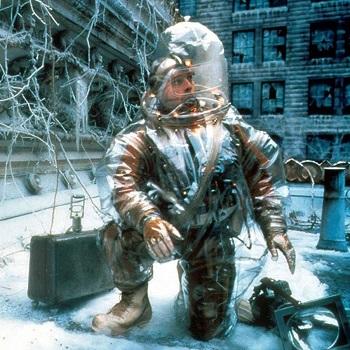
Yet another movie that largely contents itself with the aftermath of a deadly pandemic rather than the initial outbreak, 12 Monkeys more than earned its stripes on today’s list. The story of a time traveler from 2035 trying to track down the origins of a pandemic that wiped out most of the earth’s population some 40 years before, the film takes a hard, outside the box look at the notion of contact tracing, elevating it to the sci-fi realm. At its heart, 12 Monkeys is a picture about an epidemiological puzzle whose final form is already known to the audience. It’s an interesting approach to take for a pandemic flick, as it eschews all the flashy panic and paranoia that characterizes the earliest days of an outbreak and forces the audience to consider those consequences. There’s also the urgency and despair that drips through the screen as the time traveler, James Cole (Bruce Willis), tries to warn those on the cusp of a global disaster what’s to come. It’s much the same as what any one of us in 2020 might feel if given a time machine and allowed to travel to the past, and for this, it snuck in at #8 just behind…
7. The Crazies (2010)
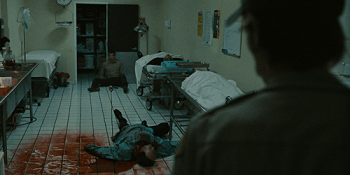
A fun micro exploration of a fast-moving disease exploding in small town America, The Crazies is the rare example of a horror remake that meets or exceeds the quality of its predecessor. The movie follows the sheriff of Ogden Marsh, Iowa, David Dutton (Timothy Olyphant), as he tries to get a handle on a surge of mayhem in his small community. Formerly passive, kindly folk begin committing savage acts of violence in Ogden Marsh, leading to the arrival of the military to quarantine Dutton and the rest of the town’s residents. Dutton and the audience learn that a military cargo plane carrying a chemical prototype named “Trixie” crashed in the marshy swamplands outside of Ogden Marsh, contaminating the town’s water supply and kicking off the violent frenzy. Sort of zombie-adjacent in its presentation of the virus and the military response, the victims are indeed alive after infection, and didn’t try to eat anyone, so this one sneaks into the conversation due to its magnificent use of confusion, paranoia, and mistrust of the government in tackling the issue in a responsible fashion.
6. It Comes at Night (2017)

A testament to the fear that spreads faster than any virus, It Comes at Night side-steps the expected macro examination of a pandemic, interested instead on the ways humans devolve in the face of an existential threat. Of course, fans of the zombie genre have walked this thematic path many times before with the whole, “the zombies aren’t the monsters, we are” bit. But when the zombies are removed from that equation and there’s just the panic and terror of the unknown outside one family’s safe space, this trope takes on a whole new life with COVID-19 now under everyone’s belts. When Paul (Joel Edgerton) and his wife/son come across another mother/father/son combo, they agree to let the trio stay in their secluded cabin deep in the woods, albeit with one eye always open. There’s a highly contagious disease ravaging the planet, so everyone’s best bet is to hole up and try to wait things out. Distrust infects the six of them more than any illness could, however, and before long, both sides are taking turns pulling guns and holding the other hostage. A taut psychological thriller that leaves the majority of the horror to the internal machinations of its panicked characters, It Comes at Night makes a lot more sense to audiences after the grocery and toilet paper shortages that characterized the earliest days of 2020’s pandemic.
5. Panic in the Streets (1950)

If you are fond of griping about how they don’t make pandemic movies like they used to, then Panic in the Streets is likely your gold standard, and for good reason. Elia Kazan’s 1950 film noir follows an MD with the U.S. Public Health Service, Reed (Richard Widmark), and his police captain sidekick, Warren (Paul Douglas), as they race to track down the origin of a fast-moving strain of pneumonic plague. The film is pure shoe leather epidemiology, with Reed and Warren piecing together clues about their patient zero’s identity and movements so that they can identify, isolate, and inoculate those he encountered. Long before the word “contact tracer” entered the popular lexicon, this movie featured a pair of them racing against the clock to halt the spread of a literal plague in steamy New Orleans. Although the movie’s heroes manage to stem the tide of the outbreak, their work battling the apathy of civil authorities and the public’s unwillingness to cooperate with their investigation presaged a very familiar reality 2020 knows all too well. Had the film dipped its toe into the earliest stages of panic brought on by its plague, it likely would have beaten out this next picture…
4. Outbreak (1995)
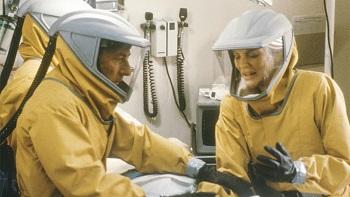
Riding the crest of the Ebola panic wave, 1995’s Outbreak gave audiences a taste of what a pandemic might look like on Mainstreet, U.S.A. A high-octane Hollywood yarn about the fictional “Motaba” virus, the film stars Dustin Hoffman as Col. Daniels, MD with the U.S. Army’s Medical Research Institute of Infectious Diseases. Hoffman spends most of the film power-walking through scenes like a wind up toy, but does a decent job portraying the urgency and basic methodology of epidemiology work. Director Wolfgang Peterson focuses less on the science and personal experiences of the afflicted and more on the fast-moving military and their quarantine of the fictional California town of Cedar Creek, which could potentially serve as the jumping off point for a devastating global pandemic if Motaba isn’t contained there. Scenes of the virus going airborne in a movie theater and the panic that spreads throughout the decision-makers (rather than the victims) is what really sets this one apart and puts it so deep in today’s ranking. Stocked full of movie stars that were all mugging for their trailer clip and a 90s action backbone, Outbreak feels a little too Hollywood at times, which is one of the few criticisms one could level at this next film…
3. And the Band Played On (1993)

Adapted from the book of the same name by journalist Randy Shilts, And the Band Played On is a devastating critique of pretty much every participant of the AIDS crisis to varying degrees, saving venom for doctors, victims, politicians, activists, and the medical industry alike. Although Shilts’ book wove in dozens of figures spanning the globe, the film set its primary focus on the doctors treating the mysterious disease during the earliest phase of the epidemic (1981 – 1985), who tapped community organizers, local physicians, and the terrified victims who were the first to suffer from the retrovirus for help. To be sure, there were a handful of people who realized the horrific implications of AIDS and its transmission vectors in the earliest days of the struggle, like CDC doctor Don Francis (Matthew Modine), San Francisco epidemiologist Selma Dritz (Lily Tomlin), and Democratic political organizer Bill Kraus (Ian McKellen), yet their voices were often drowned out.
Over year years, these key players found themselves stymied on two fronts by a new Regan administration that refused to spend money on anything that wasn’t defense-related, and in a surprising twist, a gay community that rallied vociferously against anything that they perceived as an attack on their rights (i.e., bathhouse closures). The dread and paranoia that surrounded AIDS in those early days, the sickening realization that quicker action could have saved thousands (now millions) of lives, and the two-front fight of a government and public that mobilized far too late to halt a catastrophe make this a terribly timely re-watch in 2020. New York author Larry Kramer appears in Shilts’ book (though not the movie) as one of the few who did take AIDS seriously, along with Francis, Dritz, and Kraus, and it was Kramer’s play about his struggles during the earliest years of the pandemic that made up the basis of this next entry, today’s runner-up…
2. The Normal Heart (2014)
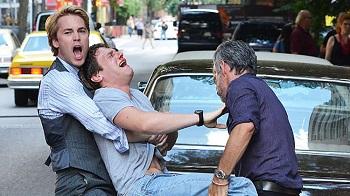
Adapted from the play of the same name by Larry Kramer, The Normal Heart is a devastating ground-level look at the ways the AIDS pandemic ravaged an entire generation. The story is largely autobiographical, and follows the efforts of Kramer, fictionalized as “Ned Weeks” (Mark Ruffalo), and the New York LGBTQ+ community’s grassroots organizing to provide resources for the scores of men getting sick throughout 1981 and beyond. The film tracks the first panicked whispers from the friends of mysteriously sick men dying horrible, lonely, painful deaths, and the apathetic response from state and government officials. The film captures the terrifying sense of the unknown surrounding the illness, and the paranoia that it engenders in social settings for doctors and patients alike.
The inability or unwillingness of the government to tackle the problem with a full raft of resources is frightfully familiar in 2020, as is the representation of the disruption of any sense of community for a population that will likely never know the previous normal again. The enduring 2020 legacy of The Normal Heart has to be its portrayal of the fractures that separate friends and family due to the pandemic, however, and the ways people divide themselves into camps based on their level of appreciation for how serious the issue really is. Like those that scoff at mask wearing, or insist that it’s no big deal to go to a crowded bar, Kramer’s story also has a gallery of gay allies who insist that closing bathhouses or curbing sexual activity is an infringement upon their rights. In The Normal Heart, Ned Weeks often laments that if AIDS had hit the straight community with the same vigor it did the gay men of New York, things would unfold differently in the press and lead to less death and devastation; in 2020, we know he was only half right.
1. Contagion (2011)
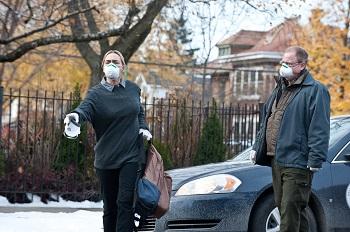
Perfect, perfect, perfect. What else can you say about this one, really? When Steven Soderbergh made Contagion in 2011, the director and his writing partner, Scott Z. Burns, consulted epidemiologist Larry Brilliant to craft a believable story about a fictional pandemic event that hewed closely to what history, experts, and research models indicated might actually transpire. The result is a film that plays in 2020 like a documentary, for it is about a novel virus that originates in Chinese bats and spreads to humans as a result of unsanitary food handling. Although the film’s flu virus (MEV-1) has a shorter incubation period and is considerably more deadly, much of what transpires in the film, from the government’s response, to the panic on the ground, to the weasels trying to make a buck off of bogus miracle drugs, is startlingly accurate. Indeed, if anything, Contagion gives too much credit to the CDC and Washington D.C., who mobilize resources quickly and “figure out how to work online” with seemingly no trouble or partisan infighting.
Overall, though, the movie hits every note of the pandemic with frightening precision, rotating perspectives between scientists, government officials, and everyday citizens without ever striking a false note. The interplay between the husband (Matt Damon) of patient zero (Gwyneth Paltrow), and his stir-crazy daughter (Anna Jacoby-Heron) is especially timely, for it shows how lockdowns, even essential ones, can begin to feel like a prison sentence. For an all-star cast that also includes Kate Winslet, Lawrence Fishburne, Jude Law, Bryan Cranston, John Hawkes and a score of others, the true star of Contagion is unquestionably MEV-1, though. Indiscriminate, blind, and waiting to latch onto a person regardless of precautions, the virus can’t be defeated or willed away, only dealt with and minimized. Watching the film in 2011 was a humbling experience, granted, but a viewing in 2020 is nothing short of a glimpse at a Nostradamus-like forecast that came about 9 years too early.





Comments on this entry are closed.